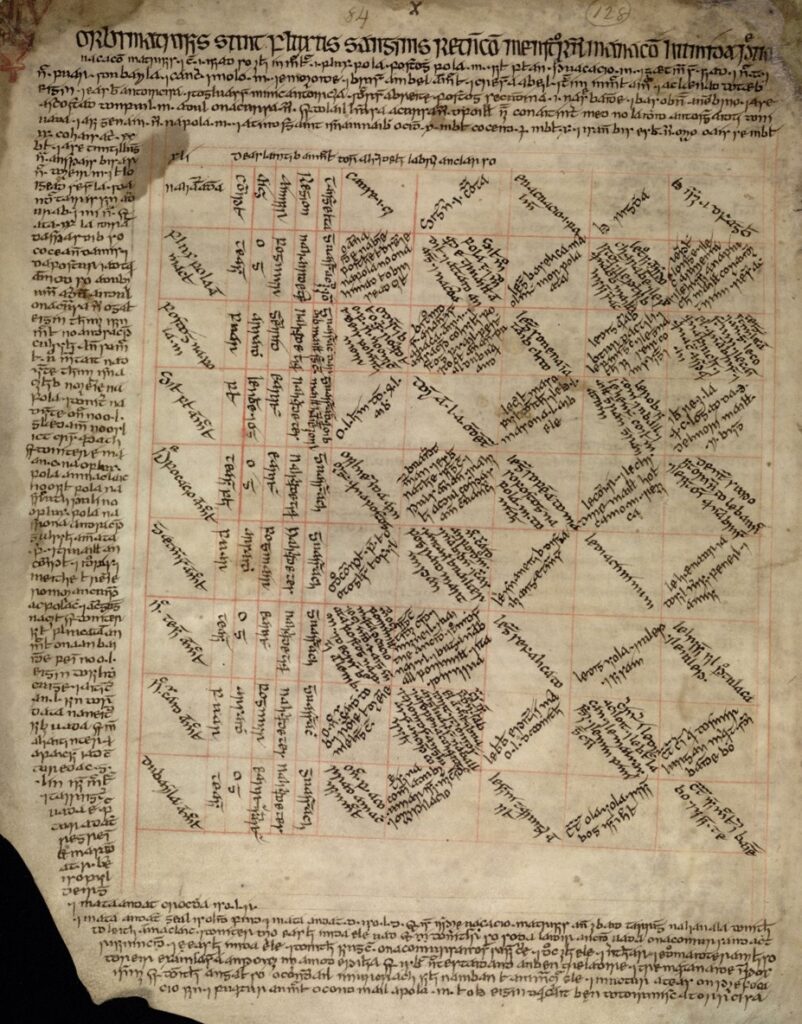Dublin, Royal Irish Academy MS 23 P 10 (ii) (‘The Book of the O’Lees’ or ‘The Book of Hy Brasil’)
Deborah Hayden

Fig. 1: Dublin, Royal Irish Academy MS 23 P 10 (ii), p. 84 (15th century): A table from the Irish version of the Tacuini aegritudinum of Ibn Jazlah (d. 1100), on diseases of the female generative organs. Image courtesy of Irish Script on Screen.
This vellum manuscript, comprising 45 folios in total, has had an intriguing afterlife since it was first copied by an anonymous scribe in the fifteenth century – possibly the year 1434, which is written in a late hand on the margin of p. 76. According to the seventeenth-century historian Roderic O’Flaherty, a contemporary of his by the name of ‘Morogh O’Ley’ (Murchadh Ó Laidhe) claimed to have been forcibly carried off by boat to the imaginary island of ‘O’Brasil’, thought by some to be located to the west of the Aran islands. Having stayed there for two days, he was returned to the mainland and, some seven or eight years later, ‘began to practise both chirurgery and phisick, and so continues ever since to practise, tho’ he never studyed nor practised either all his life time before’. In his notes on O’Flaherty’s account, the nineteenth-century historian James Hardiman observed that subsequent embellishments of this tale held that Murchadh had received a certain book (to be identified, of course, with this manuscript) from the inhabitants of O’Brasil, who told him not to open it for seven years. When he finally did so, he found had magically acquired the gift of healing. Hardiman suspected that Murchadh had most likely inherited RIA MS 23 P 10 (ii) from his ancestors, who were hereditary physicians in West Connacht, and that – having had his patrimony confiscated in the seventeenth century and ‘turned quack-doctor to obtain a livelihood’ – he invented the tale of its mysterious island origin in order to attract attention and lend credence to his medical abilities.

Fig. 2: The imaginary Isle of Brasil off the west coast of Ireland, as shown on a map by Abraham Ortelius (1572). Image in the Public Domain.
The contents of RIA MS 23 P 10 (ii) itself are, however, very much in keeping with other learned, academic textbooks compiled by medieval Irish medical scribes. The manuscript contains a beautifully presented pathological treatise arranged in a series of 44 tables, treating exterior and interior diseases of the entire body. The Irish text is a close rendering of the Latin Tacuini aegritudinum, which was completed in Sicily in 1281 and was itself a translation of an Arabic text by the eleventh-century physician Ibn Jazlah of Baghdad. Each page is framed by a preliminary discussion of the diseases arranged in rows across a central table (for observations on the contents of one of these tables, see the July 2024 LEIGHEAS blog here). The boxes at the top of each table provide headings describing the names, complexion, age, season, region, prognosis, cause, symptom, method of evacuation, ‘royal remedy’ and ‘easily found remedy’ associated with each affliction (see, for example, the table in Fig. 1 above, which presents diseases of the female generative organs). To the right of the table on the opposite page is a much longer twelfth entry detailing a universal or general remedy for the disease (see Fig. 3 below). This practical arrangement of information would have been of considerable use for medical scholars and practitioners alike.

Fig. 3: Dublin, Royal Irish Academy MS 23 P 10 (ii), p. 85 (15th century): the universal or general remedy (cura communis .i. leigheas coitcheann) for ailments of the female generative organs outlined on the preceding page (Fig. 1). Image courtesy of Irish Script on Screen.
Further Reading:
- Evans, Sophie, ‘The Mythical Island of Hy Brasil and the Book of O’Lees’, Royal Irish Academy Blog Series, 19 September 2019
- Freitag, Barbara, Hy Brasil: The Metamorphosis of an Island. From Cartographic Error to Celtic Elysium. (Amsterdam/New York: Brill-Rodopi, 2013)
- Nic Dhonnchadha, Aoibheann (2009), ‘The “Book of the O’Lees” and Other Medical Manuscripts and Astronomical Tracts’, in Treasures of the Royal Irish Academy Library, ed. by Bernadette Cunningham, Siobhán Fitzpatrick and Petra Schnabel (Dublin: RIA), pp. 81–91
- Ó Con Cheanainn, Tomás, ‘Seanchas ar Mhuintir Laidhe’, Éigse 33 (2002), 179–225
- O’Flaherty, Roderic, A Chorographical Description of West or H-Iar Connaught Written A.D. 1684, ed. by James Hardiman (Dublin, 1846), pp. 68–72